|
|
#741 |
|
⊙▃⊙
|
What's in the sky tonight?
November 14, 2013 -Look left of the waxing gibbous Moon after dusk for the two or three leading stars of Aries, lined up more or less horizontally. High above the Moon and perhaps a bit right is the Great Square of Pegasus. The Moon itself inhabits dim Pisces. -Solar activity has been low for 24+ hours, but the forecast calls for flares. Two large, complex sunspots are transiting the Earthside of the sun with mixed-polarity magnetic fields that harbor energy for strong eruptions. The next big flare will probably come from one of these two circled regions. NOAA forecasters estimate a 60% chance of M-class flares and a 30% chance of X-flares during the next 24 hours. Flares from AR1890 could be particularly geoeffective. Because of the way the sun's magnetic field spirals through interplanetary space, AR1890 is magnetically connected to our planet. Particles accelerated by an explosion there would be guided in our direction, possibly causing a radiation storm around Earth. 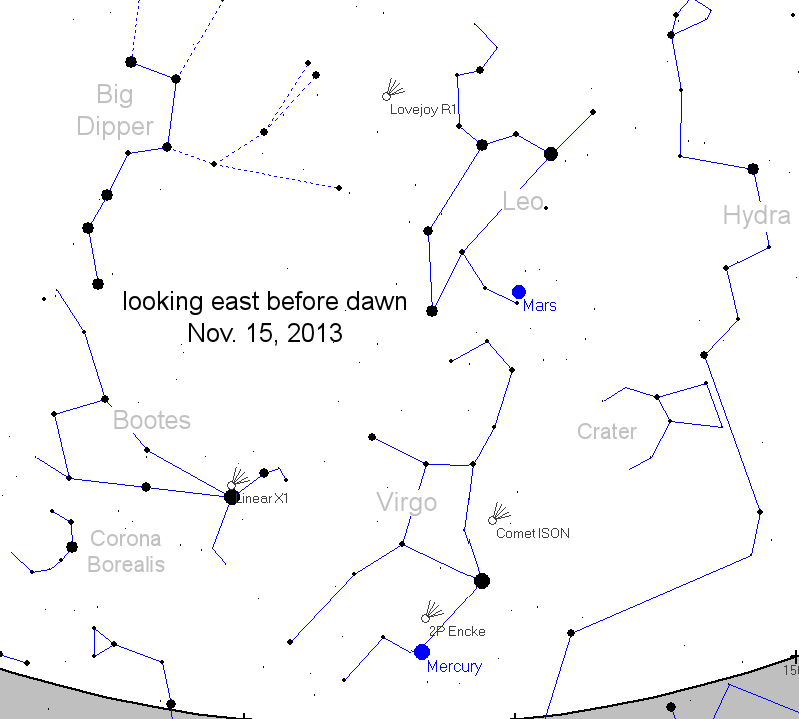 Astro Picture of the Day: November 14, 2013 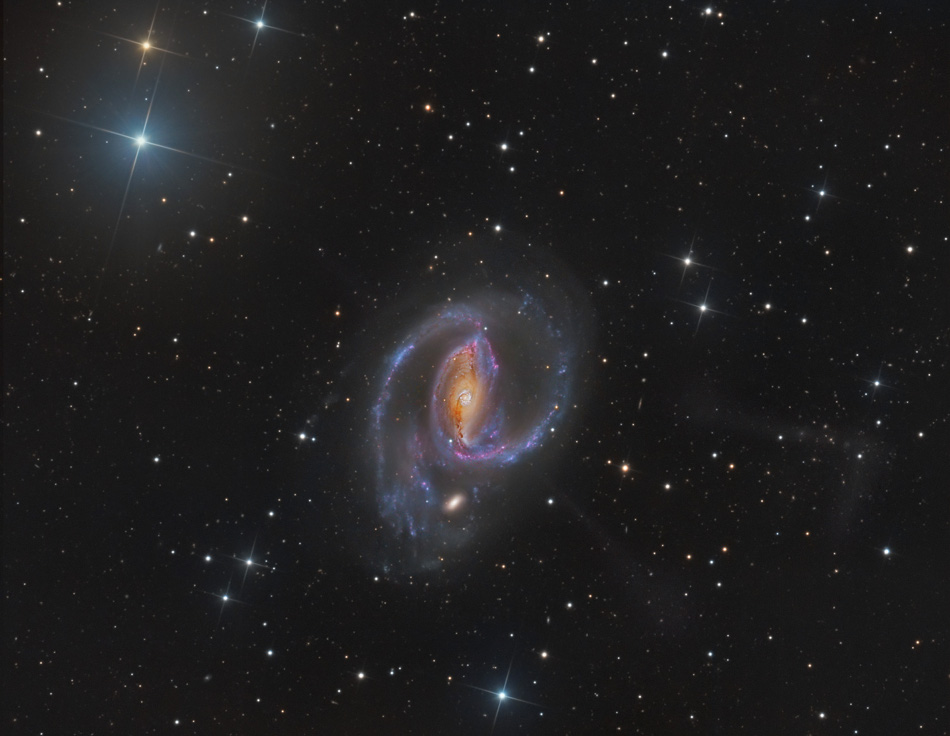 Enigmatic spiral galaxy NGC 1097 shines in southern skies, about 45 million light-years away in the chemical constellation Fornax. Its blue spiral arms are mottled with pinkish star forming regions in this colorful galaxy portrait. They seem to have wrapped around a small companion galaxy below and left of center, about 40,000 light-years from the spiral's luminous core. That's not NGC 1097's most peculiar feature, though. The very deep exposure hints of faint, mysterious jets, most easily seen to extend well beyond the bluish arms toward the lower right. In fact, four faint jets are ultimately recognized in optical images of NGC 1097. The jets trace an X centered on the galaxy's nucleus, but probably don't originate there. Instead, they could be fossil star streams, trails left over from the capture and disruption of a much smaller galaxy in the large spiral's ancient past. A Seyfert galaxy, NGC 1097's nucleus also harbors a supermassive black hole.
__________________
1st in Kommisar's 2009 SM Tournament 1st in I Love You`s 2009 New Year`s Tournament 3rd in EnR's Mashfest '08 tournament 5th in Phynx's Unofficial FFR Tournament 9th in D3 of the 2008-2009 4th Official FFR Tournament 10th in D5 of the 2010 5th Official FFR Tournament 10th in D6 of the 2011-2012 6th Official FFR Tournament FMO AAA Count: 71 FGO AAA Count: 10 Bluearrowll = The Canadian player who can not detect awkward patterns. If it's awkward for most people, it's normal for Terry. If the file is difficult but super straight forward, he has issues. If he's AAAing a FGO but then heard that his favorite Hockey team was losing by a point, Hockey > FFR PS: Cool AAA's Terry - I Love You An Alarm Clock's Haiku beep beep beep beep beep beep beep beep beep beep beep beep beep beep beep beep beep - ieatyourlvllol |
|
|

|
|
|
#742 |
|
⊙▃⊙
|
What's in the sky tonight?
November 15, 2013 -The bright star high in the west-northwest after dark this month is Vega, often associated with summer. The brightest star higher above it is Deneb. Farther to Vega's left or lower left is Altair, dimmer than Vega but outshining Deneb. These three form the Summer Triangle, which is sinking lower each week as summer becomes a distant memory. -Comet ISON has brightened suddenly in the last few days to 5th magnitude as of November 15th — a popsicle comet with a round, sharp-edged, bright green head and a long, thin, dim tail. It's speeding sunward near Spica and Mercury low in the east just before dawn. It passes less than 2° from Spica on the mornings of November 17th and 18th for the Americas, accelerating every day toward its November 28th perihelion and trial by fire. Mike Broussard of Lousiana shot Comet ISON on the morning of November 14th using a 200mm lens on a DSLR. -These changes (the increase in brightness and riotous emergence of gaseous streamers) could be caused by fresh veins of ice opening up in the comet's nucleus. Rapid vaporization of ice by solar heat is a sure-fire way to boost a comet's visibility. But, as NASA's Comet ISON Observing Campaign states, "we have no idea." The comet's nucleus is hidden from view by a hazy green atmosphere, so events in the interior remain a mystery. "I have a strong suspicion that this is Comet LINEAR (C/1999 S4) all over again," says Mark Kidger of the ESA's European Space Astronomy Centre in Madrid. In the year 2000, Kidger other astronomers monitored Comet LINEAR as it disintegrated en route to the sun. "The sudden appearance of ISON's gas tail, the increasing fuzziness of its coma, and now this sudden outburst all remind me of C/1999 S4 just before it broke apart." To reiterate: No one knows what is happening to Comet ISON. This could be the comet's death throes--or just the first of many brightening events the comet experiences as it plunges toward the sun for a close encounter on Thanksgiving Day (Nov. 28th).   Astro Picture of the Day: November 15, 2013  In a flash, the visible spectrum of the Sun changed from absorption to emission on November 3rd, during the brief total phase of a solar eclipse. That fleeting moment is captured by telephoto lens and diffraction grating in this well-timed image from clearing skies over Gabon in equatorial Africa. With overwhelming light from the Sun's disk blocked by the Moon, the normally dominant absorption spectrum of the solar photosphere is hidden. What remains, spread by the diffraction grating into the spectrum of colors to the right of the eclipsed Sun, are individual eclipse images at each wavelength of light emitted by atoms along the thin arc of the solar chromosphere. The brightest images, or strongest chromospheric emission lines, are due to Hydrogen atoms that produce the red hydrogen alpha emission at the far right and blue hydrogen beta emission to the left. In between, the bright yellow emission image is caused by atoms of Helium, an element only first discovered in the flash spectrum of the Sun.
__________________
1st in Kommisar's 2009 SM Tournament 1st in I Love You`s 2009 New Year`s Tournament 3rd in EnR's Mashfest '08 tournament 5th in Phynx's Unofficial FFR Tournament 9th in D3 of the 2008-2009 4th Official FFR Tournament 10th in D5 of the 2010 5th Official FFR Tournament 10th in D6 of the 2011-2012 6th Official FFR Tournament FMO AAA Count: 71 FGO AAA Count: 10 Bluearrowll = The Canadian player who can not detect awkward patterns. If it's awkward for most people, it's normal for Terry. If the file is difficult but super straight forward, he has issues. If he's AAAing a FGO but then heard that his favorite Hockey team was losing by a point, Hockey > FFR PS: Cool AAA's Terry - I Love You An Alarm Clock's Haiku beep beep beep beep beep beep beep beep beep beep beep beep beep beep beep beep beep - ieatyourlvllol |
|
|

|
|
|
#743 |
|
⊙▃⊙
|
What's in the sky tonight?
November 16, 2013 -The Moon is almost equally full this evening and tomorrow evening. Tonight, look above the Moon for the leading star or two of Aries glimmering through the moonlight. To the Moon's left are the Pleiades, as shown at right. Much farther left twinkles bright Capella. -The sunspot number is so high, it is starting to confuse photographers. Consider this story from Beijing, China, on the morning of Nov. 15th: "Beijing is usually very polluted and we often miss seeing the sun rise in the morning," says Shalini Purohit. "Today, however, the morning sky was clear and I decided to take some pictures. When I looked at the image I thought there must be come specks of dust on my lens." In fact, the lens was clean; those specks were sunspots. When the sunspot number is high, so is the chance of flares. NOAA forecasters estimate a 50% chance of M-class flares and a 15% chance of X-flares during the next 24 hours. As Purohit's image shows, at least four of the sun's spots are facing Earth. If any eruptions do occur, they will likely be geoeffective.  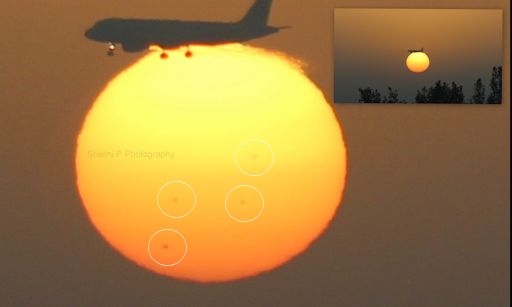  Astro Picture of the Day: November 16, 2013 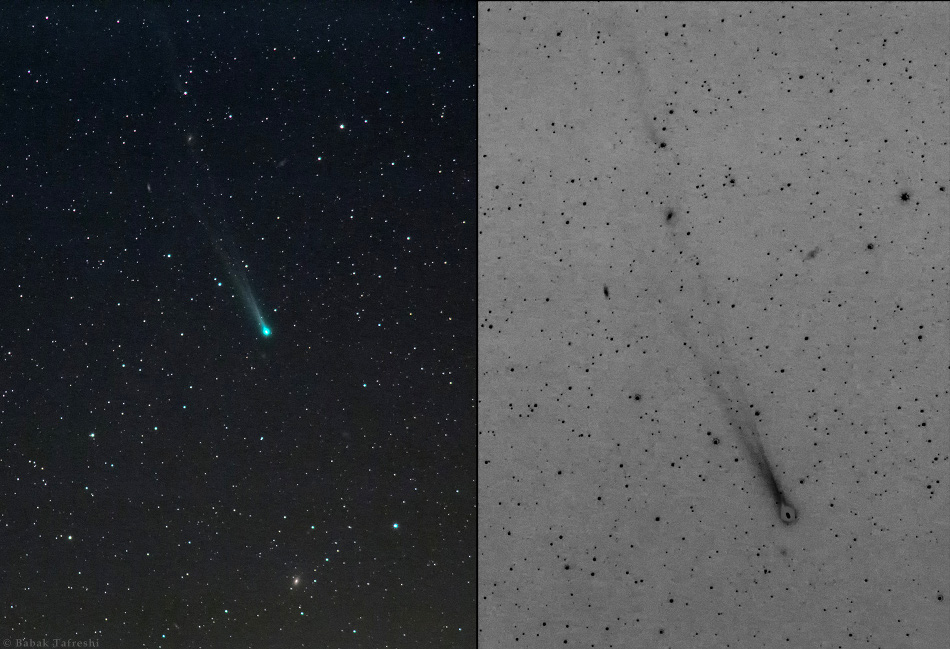 Falling through planet Earth's predawn skies toward its close encounter with the Sun on November 28, Comet ISON is coming to life. The much anticipated comet has now been reported to have substantially increased in brightness, surging to naked-eye visibility for dark sites and sprouting a more complex tail. ISON's tail stretches over two degrees in this telephoto skyview from southern Kenya, captured on the morning of November 15. Shown in two panels, the enlarged negative version on the right makes details of the long tail easier to trace, including the tail's separated filaments toward the top of the frame. A sungrazer and first time visitor to the inner solar system, the possibility of ISON's survival to become a bright comet in planet Earth's December skies remains a question.
__________________
1st in Kommisar's 2009 SM Tournament 1st in I Love You`s 2009 New Year`s Tournament 3rd in EnR's Mashfest '08 tournament 5th in Phynx's Unofficial FFR Tournament 9th in D3 of the 2008-2009 4th Official FFR Tournament 10th in D5 of the 2010 5th Official FFR Tournament 10th in D6 of the 2011-2012 6th Official FFR Tournament FMO AAA Count: 71 FGO AAA Count: 10 Bluearrowll = The Canadian player who can not detect awkward patterns. If it's awkward for most people, it's normal for Terry. If the file is difficult but super straight forward, he has issues. If he's AAAing a FGO but then heard that his favorite Hockey team was losing by a point, Hockey > FFR PS: Cool AAA's Terry - I Love You An Alarm Clock's Haiku beep beep beep beep beep beep beep beep beep beep beep beep beep beep beep beep beep - ieatyourlvllol |
|
|

|
|
|
#744 |
|
⊙▃⊙
|
What's in the sky tonight?
November 17, 2013 -Comet ISON is within 2° of Spica this morning and Monday morning as seen from the Americas. Their closest approach, 1/3°, comes around 1h November 18th Universal Time, good timing for observers in the longitudes of eastern Europe and western Asia. -Reports of naked-eye sightings of Comet ISON are coming in from around the world. Experienced observers put the comet's magntitude at +5.5 on Nov. 16th. This means it is now fully 10 times brighter than it was only three days ago before the outburst. To the naked eye, ISON appears as a faint smudge of pale green light low in the pre-dawn sky. The view through a telescope is more dramatic. The comet's tail has become a riotous crowd of gaseous streamers stretching more than 3.5 degrees across the sky. Amateur astronomer Waldemar Skorupa sends this picture from Kahler Asten, Germany. -The tail is so long, he couldn't fit the whole thing in the field of view. How long is it? Comet ISON's tail extends more than 8 million kilometers behind the comet's nucleus. For comparison, that's 21 times the distance between Earth and the Moon. Because so much gas and dust is spewing from the comet's core, it is impossible to see clearly what caused Comet ISON's outburst on Nov. 13-14. One possibility is that fresh veins of ice are opening up in the comet's nucleus, vaporizing furiously as ISON approaches the sun. Another possibility is that the nucleus has completely fragmented. "If so, it will still be several days before we know for sure," says Karl Battams, an astronomer with NASA's Comet ISON Observing Campaign. "When comet nuclei fall apart, it’s not like a shrapnel-laden explosion. Instead, the chunks slowly drift apart at slightly different speeds. Given that ISON’s nucleus is shrouded in such a tremendous volume of light-scattering dust and gas right now, it will be almost impossible to determine this for at least a few days and perhaps not until the comet reaches the field of view of NASA's STEREO HI-1A instrument on November 21, 2013. We will have to wait for the chunks to drift apart a sufficient distance, assuming they don't crumble first." In short, no one knows for sure what is happening to Comet ISON. This could be the comet's death throes--or just the first of many brightening events the comet experiences as it plunges toward the sun for a close encounter on American Thanksgiving Day.  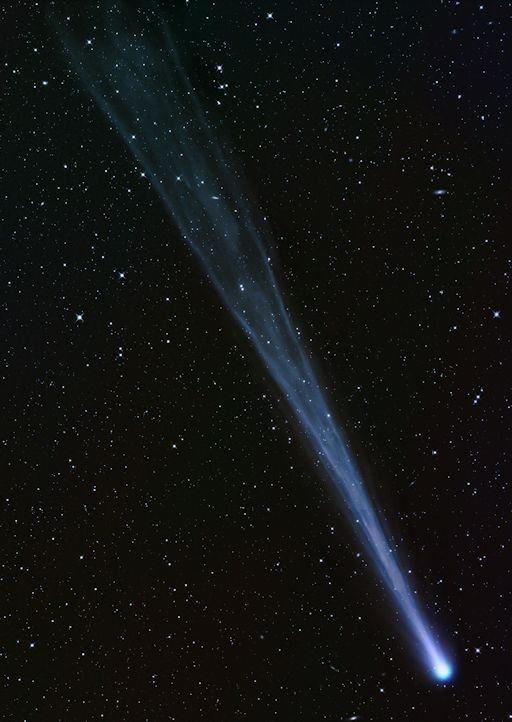  Astro Picture of the Day: November 17, 2013  Comet McNaught, the Great Comet of 2007, grew a spectacularly long and filamentary tail. The magnificent tail spread across the sky and was visible for several days to Southern Hemisphere observers just after sunset. The amazing tail showed its greatest extent on long-duration, wide-angle camera exposures. During some times, just the tail itself estimated to attain a peak brightness of magnitude -5 (minus five), was caught by the comet's discoverer in the above image just after sunset in January 2007 from Siding Spring Observatory in Australia. Comet McNaught, the brightest comet in decades, then faded as it moved further into southern skies and away from the Sun and Earth. Within the next two weeks of 2013, rapidly brightening Comet ISON might sprout a tail that rivals even Comet McNaught.
__________________
1st in Kommisar's 2009 SM Tournament 1st in I Love You`s 2009 New Year`s Tournament 3rd in EnR's Mashfest '08 tournament 5th in Phynx's Unofficial FFR Tournament 9th in D3 of the 2008-2009 4th Official FFR Tournament 10th in D5 of the 2010 5th Official FFR Tournament 10th in D6 of the 2011-2012 6th Official FFR Tournament FMO AAA Count: 71 FGO AAA Count: 10 Bluearrowll = The Canadian player who can not detect awkward patterns. If it's awkward for most people, it's normal for Terry. If the file is difficult but super straight forward, he has issues. If he's AAAing a FGO but then heard that his favorite Hockey team was losing by a point, Hockey > FFR PS: Cool AAA's Terry - I Love You An Alarm Clock's Haiku beep beep beep beep beep beep beep beep beep beep beep beep beep beep beep beep beep - ieatyourlvllol |
|
|

|
|
|
#745 |
|
⊙▃⊙
|
What's in the sky tonight?
November 18, 2013 -This evening look right of the just-past-full Moon for Aldebaran. Later in the evening, Orion rises below them. -Comet's ISON's recent outburst of activity has done more than simply brighten the comet. Whatever exploded from the comet's core also created a spectacularly-long tail, more than 16 million kilometers from end to end. Scroll down to see the full extent of Comet ISON as photographed on Nov. 17th by Michael Jäger of Ebenwaldhöhe, Austria. "The tail of the comet stretches more than 7o across the sky," says Jäger. It's almost as wide as the bowl of the Big Dipper. Physically, ISON's tail is about 12 times wider than the sun. So, when the head of ISON plunges into the sun's atmosphere on Nov. 28th, more than 15 million kilometers of the comet's tail will still be jutting into space behind it. Because so much gas and dust is spewing from the comet's core, it is impossible to see clearly what caused Comet ISON's outburst on Nov. 13-14. One possibility is that fresh veins of ice are opening up in the comet's nucleus, vaporizing furiously as ISON approaches the sun. Another possibility is that the nucleus has completely fragmented. "If so, it will still be several days before we know for sure," says Karl Battams, an astronomer with NASA's Comet ISON Observing Campaign. "When comet nuclei fall apart, it’s not like a shrapnel-laden explosion. Instead, the chunks slowly drift apart at slightly different speeds. Given that ISON’s nucleus is shrouded in such a tremendous volume of light-scattering dust and gas right now, it will be almost impossible to determine this for at least a few days and perhaps not until the comet reaches the field of view of NASA's STEREO HI-1A instrument on November 21, 2013. We will have to wait for the chunks to drift apart a sufficient distance, assuming they don't crumble first."  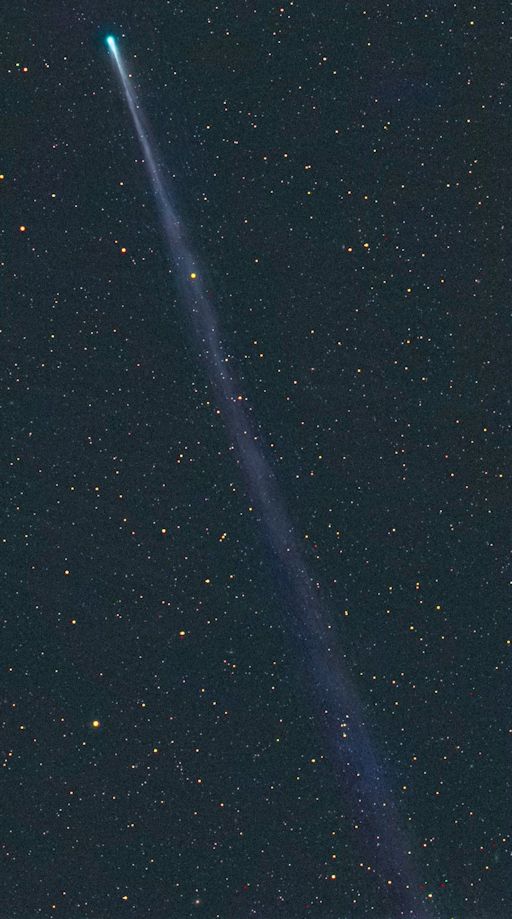  Astro Picture of the Day: November 18, 2013  What's happening in the sky? On this cold winter night in Iceland, quite a lot. First, in the foreground, lies the largest glacier in Iceland: Vatnajokull. On the far left, bright green auroras appear to emanate from the glacier as if it was a volcano. Aurora light is reflected by the foreground lake Jökulsárlón. On the far right is a long and unusual lenticular cloud tinged with green light emitted from another aurora well behind it. Just above this lenticular cloud are unusual iridescent lenticular clouds displaying a broad spectral range of colors. Far beyond the lenticular is the setting Moon, while far beyond even the Moon are setting stars. The above image was captured in late March of 2012.
__________________
1st in Kommisar's 2009 SM Tournament 1st in I Love You`s 2009 New Year`s Tournament 3rd in EnR's Mashfest '08 tournament 5th in Phynx's Unofficial FFR Tournament 9th in D3 of the 2008-2009 4th Official FFR Tournament 10th in D5 of the 2010 5th Official FFR Tournament 10th in D6 of the 2011-2012 6th Official FFR Tournament FMO AAA Count: 71 FGO AAA Count: 10 Bluearrowll = The Canadian player who can not detect awkward patterns. If it's awkward for most people, it's normal for Terry. If the file is difficult but super straight forward, he has issues. If he's AAAing a FGO but then heard that his favorite Hockey team was losing by a point, Hockey > FFR PS: Cool AAA's Terry - I Love You An Alarm Clock's Haiku beep beep beep beep beep beep beep beep beep beep beep beep beep beep beep beep beep - ieatyourlvllol |
|
|

|
|
|
#746 |
|
⊙▃⊙
|
What's in the sky tonight?
November 19, 2013 -After 9 or 10 this evening, you'll find the waning gibbous Moon shining inside a huge quadrilateral: Capella to the Moon's upper left, Aldebaran to the Moon's upper right, Betelgeuse closer to its lower right, and bright Jupiter far to its lower left. -Today, Nov. 19th, Earth is passing through a narrow stream of debris from Comet Tempel-Tuttle, source of the annual Leonid meteor shower. "The Leonids are showing up nicely in our data from the Canadian Meteor Orbit Radar (CMOR)," reports Peter Brown of the University of Western Ontario. "Rates are only about 10 per hour, but the shower is definitely active, if muted due to moonlight this year!" -To listen to the meteor shower tonight, visit http://spaceweatherradio.com/ -prawling sunspot AR1897 erupted on Nov. 19th (10:26 UT), producing an X1-class solar flare. NASA's Solar Dynamics Observatory recorded the explosion's extreme ultraviolet flash. Although the sunspot is not directly facing Earth, the flare did affect our planet. Mainly, the UV flash produced a wave of ionization in the upper atmosphere over Europe, Africa and parts of Asia. A brief blackout of HF radio transmissions around the poles might have also occurred. First-look coronagraph data from NASA's STEREO-Ahead probe show a CME emerging from the blast site, but it is probably not heading for Earth. -On Nov. 19, 2013, the network reported 31 fireballs. (21 sporadics, 10 Leonids) This number is expected to increase tonight with the advent of the Leonid meteor shower. Refer to the meteor tracker for more detailed charts.  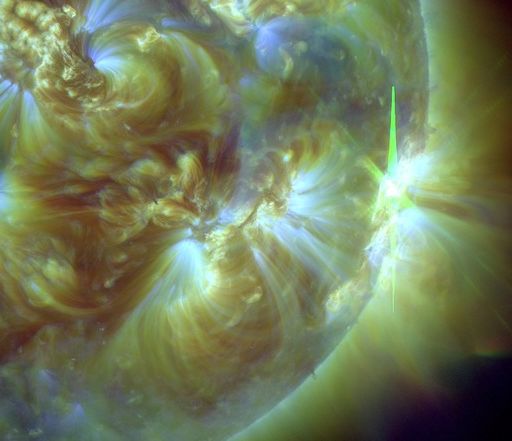  Astro Picture of the Day: November 19, 2013 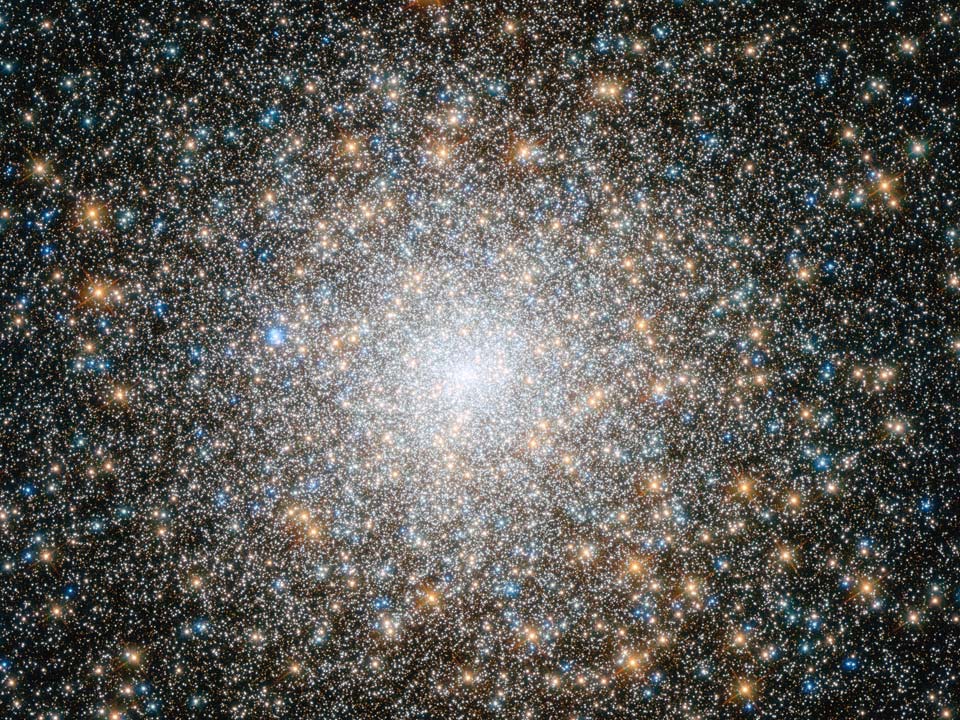 Stars, like bees, swarm around the center of bright globular cluster M15. This ball of over 100,000 stars is a relic from the early years of our Galaxy, and continues to orbit the Milky Way's center. M15, one of about 170 globular clusters remaining, is noted for being easily visible with only binoculars, having at its center one of the densest concentrations of stars known, and containing a high abundance of variable stars and pulsars. Released only recently, this sharp image taken by the Earth-orbiting Hubble Space Telescope spans about 120 light years. It shows the dramatic increase in density of stars toward the cluster's center. M15 lies about 35,000 light years away toward the constellation of the Winged Horse (Pegasus).
__________________
1st in Kommisar's 2009 SM Tournament 1st in I Love You`s 2009 New Year`s Tournament 3rd in EnR's Mashfest '08 tournament 5th in Phynx's Unofficial FFR Tournament 9th in D3 of the 2008-2009 4th Official FFR Tournament 10th in D5 of the 2010 5th Official FFR Tournament 10th in D6 of the 2011-2012 6th Official FFR Tournament FMO AAA Count: 71 FGO AAA Count: 10 Bluearrowll = The Canadian player who can not detect awkward patterns. If it's awkward for most people, it's normal for Terry. If the file is difficult but super straight forward, he has issues. If he's AAAing a FGO but then heard that his favorite Hockey team was losing by a point, Hockey > FFR PS: Cool AAA's Terry - I Love You An Alarm Clock's Haiku beep beep beep beep beep beep beep beep beep beep beep beep beep beep beep beep beep - ieatyourlvllol |
|
|

|
|
|
#747 |
|
⊙▃⊙
|
What's in the sky tonight?
November 20, 2013 -By late evening the waning Moon is up in the east. It's now part of a long, ragged, roughly horizontal snake. From right to left: Rigel in Orion's foot in the east-southeast, Orion's Belt, Betelgeuse, the Moon, Jupiter, Pollux, and above Pollux, Castor. -Astronomers working with the TRAPPIST telescope at ESO's La Silla Observatory report that Comet ISON's production of gas and dust surged another six-fold during the early hours of Nov. 19th. This marks the second outburst since Nov. 13th. Experienced observers put the comet's rising magnitude near +4.0, well above the threshold of naked-eye visibility. The problem is, ISON is approaching the sun and becoming increasingly difficult to observe. Shahrin Ahmad of Kuala Lumpur, Malaysia, photographed the comet's green core framed by twilight blue on the morning of Nov. 19th. -The situation is only going to worsen as the comet plunges toward its Nov. 28th close encounter with the sun. Amateur photography of the comet will be possible for a few more days and, soon, only NASA's fleet of solar observatories will be able to track the sundiver. 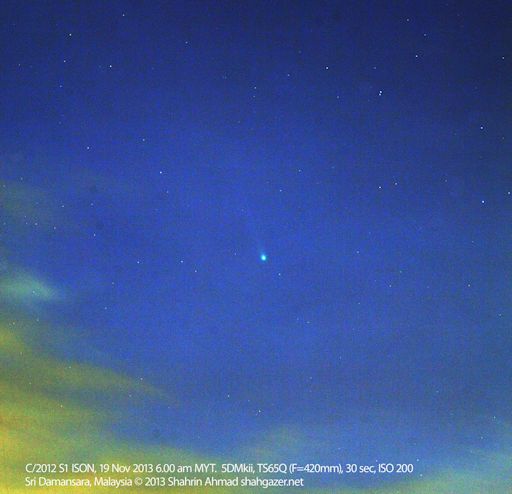 Astro Picture of the Day: November 20, 2013 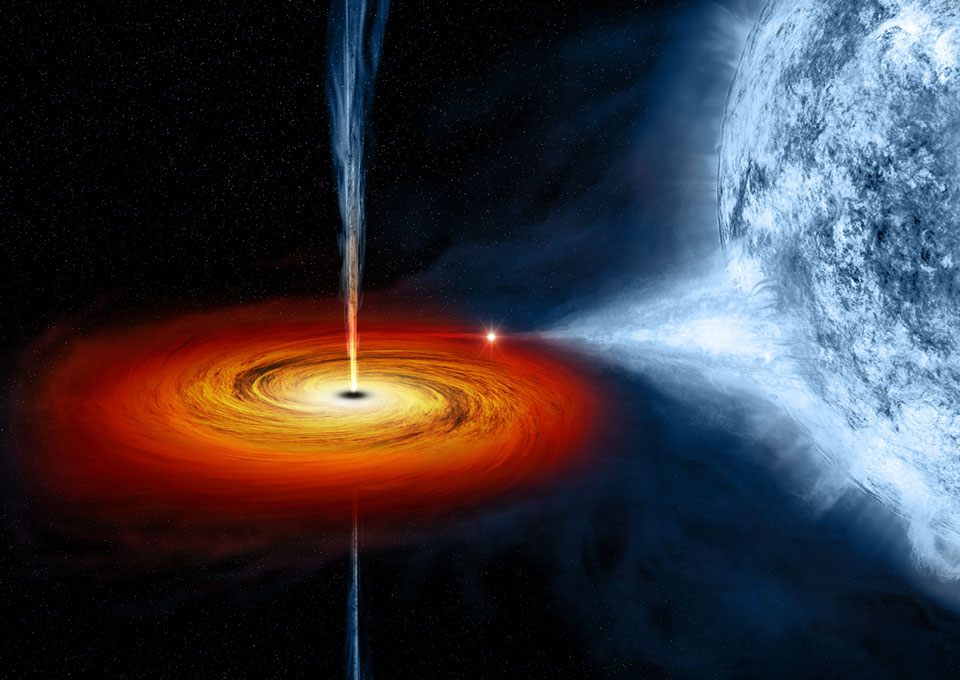 What are black hole jets made of? Many black holes in stellar systems are surely surrounded by disks of gas and plasma gravitationally pulled from a close binary star companion. Some of this material, after approaching the black hole, ends up being expelled from the star system in powerful jets emanating from the poles of the spinning black hole. Recent evidence indicates that these jets are composed not only electrons and protons, but also the nuclei of heavy elements such as iron and nickel. The discovery was made in system 4U1630-47 using CSIRO’s Compact Array of radio telescopes in eastern Australia, and the European Space Agency's Earth-orbiting XMM-Newton satellite. The 4U1630-47 star system is depicted above in an artist's illustration, with a large blue star on the right and jets emanating from a black hole in the center of the accretion disc on the left. Although the 4U1630-47 star system is thought to contain only a small black hole - a few times the mass of our Sun - the implications of the results may be larger: that black holes of larger sizes might also be emitting jets of massive nuclei into the cosmos.
__________________
1st in Kommisar's 2009 SM Tournament 1st in I Love You`s 2009 New Year`s Tournament 3rd in EnR's Mashfest '08 tournament 5th in Phynx's Unofficial FFR Tournament 9th in D3 of the 2008-2009 4th Official FFR Tournament 10th in D5 of the 2010 5th Official FFR Tournament 10th in D6 of the 2011-2012 6th Official FFR Tournament FMO AAA Count: 71 FGO AAA Count: 10 Bluearrowll = The Canadian player who can not detect awkward patterns. If it's awkward for most people, it's normal for Terry. If the file is difficult but super straight forward, he has issues. If he's AAAing a FGO but then heard that his favorite Hockey team was losing by a point, Hockey > FFR PS: Cool AAA's Terry - I Love You An Alarm Clock's Haiku beep beep beep beep beep beep beep beep beep beep beep beep beep beep beep beep beep - ieatyourlvllol |
|
|

|
|
|
#748 |
|
⊙▃⊙
|
What's in the sky tonight?
November 21, 2013 -Jupiter is the bright "star" upper left of the Moon late this evening. Although they look close together, Jupiter is currently 1,660 times farther away. And Pollux and Castor, to Jupiter's left and upper left, are 500,000 and 730,000 times farther than Jupiter! (at 34 and 52 light-years, respectively). -Comet ISON is plunging toward the sun at 140,000 mph (62 km/s). You can almost feel the velocity in this image taken on the morning of Nov. 20th by astronomers using the 0.4 meter telescope at the Observatorio de la Hita in La Puebla de Almoradiel, Toledo, Spain. "The comet looked very bright," report the observing team. "The tail was not as well defined today because of the proximity of morning twilight...but still splendid!!" The comet is brightening rapidly as it approaches the sun. Experienced observers put ISON's rising magnitude near +4.0, well above the threshold of naked-eye visibility. The problem is, the glare of the sun is brightening even faster. Amateur photography of the comet will be possible for a few more days and, soon, only NASA's fleet of solar observatories will be able to track the sundiver. -Observationally speaking, the next big event in the timeline of Comet ISON's journey comes on Nov. 21st when the comet enters the field of view of NASA's STEREO-A spacecraft. The Heliospheric Imager on STEREO-A will pick up the comet just as Earth-bound telescopes begin to lose it. In the days that follow, STEREO-B, SOHO and the Solar Dynamics Observatory will join the hunt, providing continuous views of Comet ISON all the way to perihelion (closest approach to the sun) on Nov. 28th.  Astro Picture of the Day: November 21, 2013 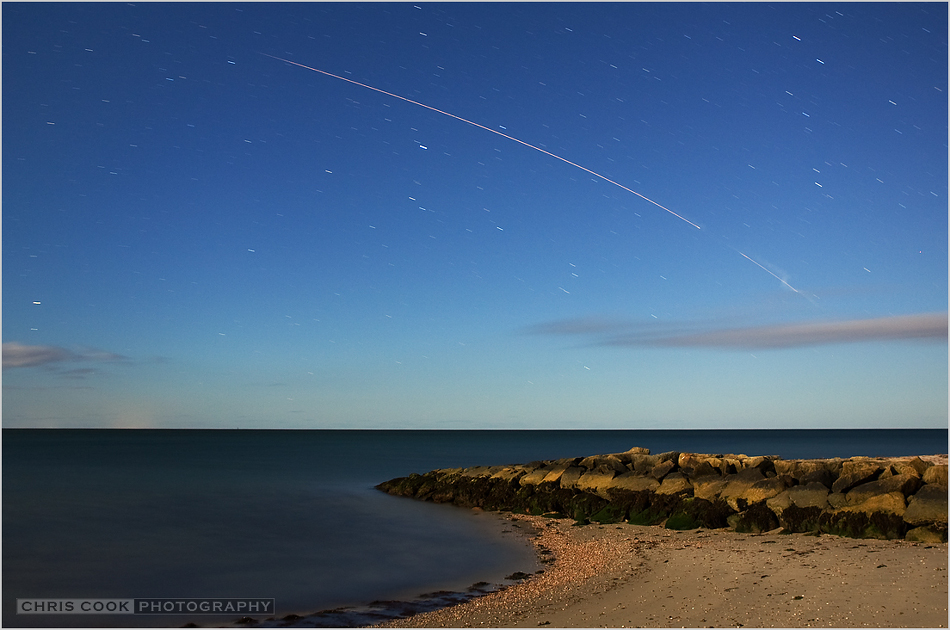 Star trails arc above a moonlit beach and jetty in this serene sea and night skyscape. Captured on November 19, the single time exposure looks south down the Atlantic coast from Cape Cod, Massachusetts, USA. But the longest and brightest trail is a Minotaur 1 rocket, a stage separation and exhaust plume visible along the rocket's fiery path toward low Earth orbit. The multi-stage Minotaur was launched from the Mid-Atlantic Regional Spaceport at NASA's Wallops Flight Facility at 8:15 p.m Eastern Time in Virginia, about 400 miles away. On board were a remarkable 29 satellites destined for low Earth orbit, including a small cubesat built by high school students, and Firefly, a satellite that will study lightning to see if they generate gamma ray bursts.
__________________
1st in Kommisar's 2009 SM Tournament 1st in I Love You`s 2009 New Year`s Tournament 3rd in EnR's Mashfest '08 tournament 5th in Phynx's Unofficial FFR Tournament 9th in D3 of the 2008-2009 4th Official FFR Tournament 10th in D5 of the 2010 5th Official FFR Tournament 10th in D6 of the 2011-2012 6th Official FFR Tournament FMO AAA Count: 71 FGO AAA Count: 10 Bluearrowll = The Canadian player who can not detect awkward patterns. If it's awkward for most people, it's normal for Terry. If the file is difficult but super straight forward, he has issues. If he's AAAing a FGO but then heard that his favorite Hockey team was losing by a point, Hockey > FFR PS: Cool AAA's Terry - I Love You An Alarm Clock's Haiku beep beep beep beep beep beep beep beep beep beep beep beep beep beep beep beep beep - ieatyourlvllol |
|
|

|
|
|
#749 |
|
⊙▃⊙
|
What's in the sky tonight?
November 22, 2013 -The waning gibbous Moon is up in the east by about 10 p.m. tonight (depending on where you live). Look above it for bright Jupiter and, to Jupiter's left, Pollux and Castor. To the Moon's right twinkles Procyon. Much farther to the right, brighter Sirius is rising or soon to rise. -Comet ISON is plunging toward the sun and brightening as it heads for a perilous close encounter on Nov. 28th. Yesterday morning, with the "final countdown" clock at T-7 days, Juan Carlos Casado photographed the sundiver over the Teide Observatory in the Canary Islands -"The comet is over the distant island of Gran Canaria," he says, "while in the central cloud we can see the planet Mercury. ISON was at the limit of naked-eye visibility, but it was an easy target for my SLR camera with a small telephoto lens (85 mm focal length) on a static tripod and 6 seconds of exposure." Because Comet ISON is moving into the rosy glow of dawn, it will soon be impossible for cameras on Earth to track it. Fortunately, NASA's fleet of solar spacecraft are able to follow the comet into the glare. NASA's STEREO-A spacecraft has already picked up Comet ISON. In the days ahead, STEREO-B, SOHO and the Solar Dynamics Observatory will join the hunt, providing continuous views all the way to perihelion (closest approach to the sun) on Nov. 28th. -Because NASA's twin STEREO probes are designed to observe the sun, they can see sundiving comets even when the glare becomes intense. Yesterday, Comet ISON joined Earth, Mercury, and Comet Encke in the field of view of STEREO-A's Heliospheric Imager. "The dark 'clouds' of stuff you see coming from the right are density enhancements in the solar wind, and these are what are causing all the ripples you see in comet Encke's tail," explains Karl Battams of NASA's Comet ISON Observing Campaign. "I can pretty much promise you that we're going to see ISON's tail doing that in a couple of day's time, but on a much larger scale!" Battams points out another exciting development: Comet Encke and Comet ISON are converging for a photogenic close encounter. "No they're not going to hit each other - in reality they are millions of miles apart - but as seen from the STEREO-A spacecraft, they are going to get very close!" he says. "We are probably a couple of days away from seeing two comets almost side-by-side in that camera, with long tails flowing behind them in the solar wind. To say that such an image will be unprecedented is rather an understatement." 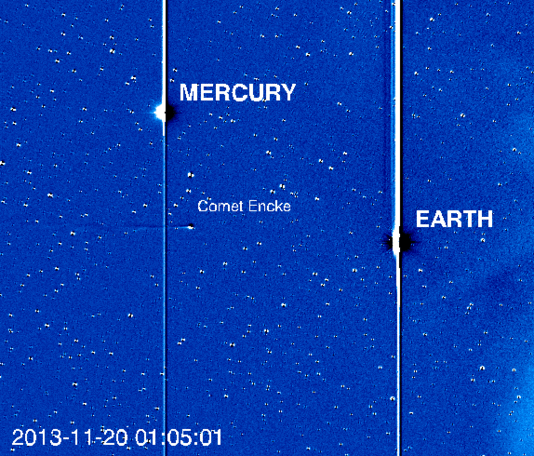 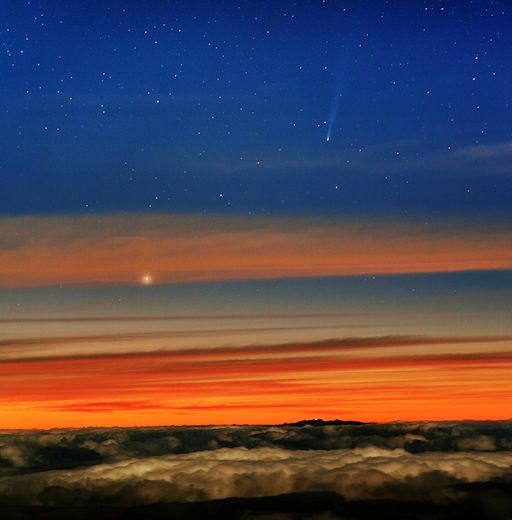 Astro Picture of the Day: November 22, 2013 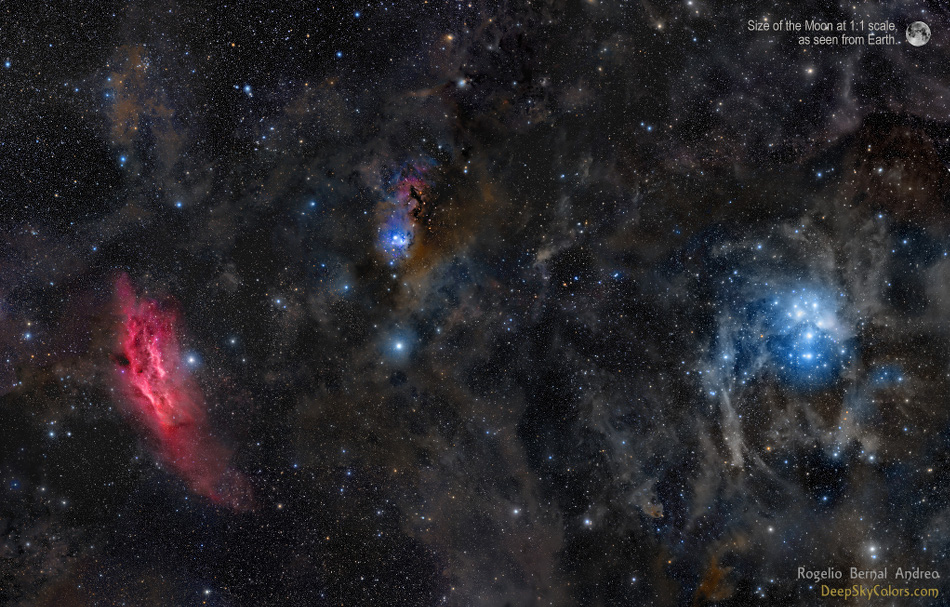 An astronomical trip from the California Nebula to the Pleiades star cluster would cover just over 12 degrees across planet Earth's night sky. That's equivalent to the angular extent of 25 Full Moons, as your telescope sweeps past the borders of the constellations Perseus and Taurus. This wide and deep mosaic image of the region explores the cosmic landscape's dusty nebulae and colors otherwise too faint for your eye to see. On the left, cataloged as NGC 1499, the California Nebula does have a familiar shape, though its coastline is actually over 60 light-years long and lies about 1,500 light-years away. The nebula's pronounced reddish glow is from hydrogen atoms ionized by luminous blue star Xi Persei seen just to its right. At the far right, the famous Pleiades star cluster is some 400 light-years distant and around 15 light-years across. Its spectacular blue color is due to the reflection of starlight by interstellar dust. In between are hot stars of the Perseus OB2 association and dusty, dark nebulae along the edge of the nearby, massive Perseus molecular cloud.
__________________
1st in Kommisar's 2009 SM Tournament 1st in I Love You`s 2009 New Year`s Tournament 3rd in EnR's Mashfest '08 tournament 5th in Phynx's Unofficial FFR Tournament 9th in D3 of the 2008-2009 4th Official FFR Tournament 10th in D5 of the 2010 5th Official FFR Tournament 10th in D6 of the 2011-2012 6th Official FFR Tournament FMO AAA Count: 71 FGO AAA Count: 10 Bluearrowll = The Canadian player who can not detect awkward patterns. If it's awkward for most people, it's normal for Terry. If the file is difficult but super straight forward, he has issues. If he's AAAing a FGO but then heard that his favorite Hockey team was losing by a point, Hockey > FFR PS: Cool AAA's Terry - I Love You An Alarm Clock's Haiku beep beep beep beep beep beep beep beep beep beep beep beep beep beep beep beep beep - ieatyourlvllol |
|
|

|
|
|
#750 |
|
⊙▃⊙
|
What's in the sky tonight?
November 23, 2013 -The eclipsing binary star Algol should be at minimum light, magnitude 3.4 instead of its usual 2.3, for a couple hours centered on 9:06 p.m. Eastern Standard Time. It takes several more hours to fade and to rebrighten. -A cluster of active sunspots has just rotated off the Earthside of the sun. The remaining sunspots facing Earth are quiet, prompting NOAA forecasters to downgrade the chance of geoeffective flares. The odds of an X-class eruption today are no more than 1%. Astro Picture of the Day: November 23, 2013 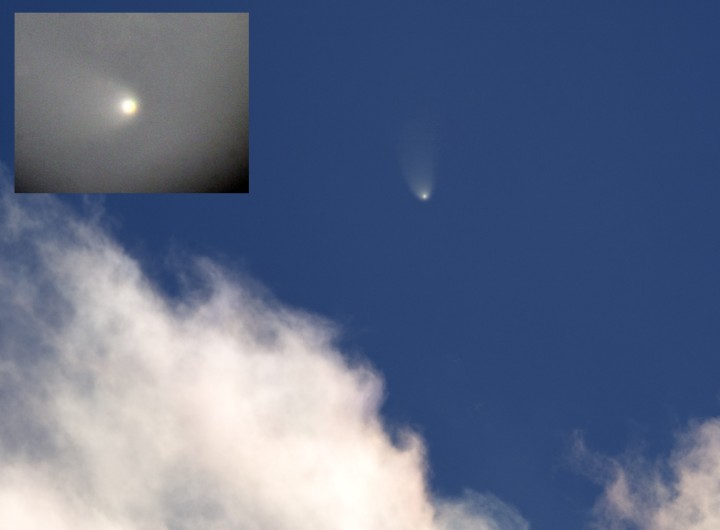 Comets grow bright when they're close to the Sun, basking in the intense solar radiation. Of course, they're also usually impossible to see against the overwhelming scattered sunlight. But surprising Comet McNaught - whose January 12 closest approach to the Sun (perihelion passage) in 2007 was well inside the orbit of Mercury - gave an enjoyable performance in bright blue daytime skies. In fact, comet expert David Levy captured this remarkable inset (upper left) telescopic view of McNaught within an hour of perihelion, with the comet in broad daylight only about 7 degrees away from the Sun's position. Stefan Seip's wider daytime view of the comet and fluffy clouds was recorded approximately a day later. Seip used a polarizing filter and a telescope/camera set up near Stuttgart, Germany. No longer visible in broad daylight, Comet McNaught is now touring twilight southern skies.
__________________
1st in Kommisar's 2009 SM Tournament 1st in I Love You`s 2009 New Year`s Tournament 3rd in EnR's Mashfest '08 tournament 5th in Phynx's Unofficial FFR Tournament 9th in D3 of the 2008-2009 4th Official FFR Tournament 10th in D5 of the 2010 5th Official FFR Tournament 10th in D6 of the 2011-2012 6th Official FFR Tournament FMO AAA Count: 71 FGO AAA Count: 10 Bluearrowll = The Canadian player who can not detect awkward patterns. If it's awkward for most people, it's normal for Terry. If the file is difficult but super straight forward, he has issues. If he's AAAing a FGO but then heard that his favorite Hockey team was losing by a point, Hockey > FFR PS: Cool AAA's Terry - I Love You An Alarm Clock's Haiku beep beep beep beep beep beep beep beep beep beep beep beep beep beep beep beep beep - ieatyourlvllol |
|
|

|
|
|
#751 |
|
⊙▃⊙
|
What's in the sky tonight?
November 24, 2013 -During dawn Monday and Tuesday mornings, when you're preparing to use binoculars or a telescope to make one last pre-perihelion try for Comet ISON barely above the bright horizon, you'll find Mercury and fainter Saturn shining to the naked eye just 3/4° apart (at the times of dawn in North America). They're well above the spot to look for the comet: by 7° on Monday, 9° on Tuesday. -In a telescope, Mercury will be a tiny, slightly gibbous disk 5.6 arcseconds in diameter (no bigger than Mars, high in the southeast), while Saturn is dimmer but much larger: 34″ across its rings. They're a nice consolation prize! -NASA's STEREO-A spacecraft is monitoring Comet ISON as it approaches the sun for a close encounter on Nov. 28th. The latest movie from the spacecraft's Heliospheric Imager captures not only Comet ISON but also Earth, Mercury, and Comet Encke. In the movie, which spans a two day period from Nov. 19 to Nov. 22, the sun is to the right, off-screen. "The dark 'clouds' coming from that direction are density enhancements in the solar wind, and these are what are causing the ripples you see in the comet tails," explains Karl Battams of NASA's Comet ISON Observing Campaign. Although the two comets seem to be experiencing the same solar wind, their tails ripple differently. "Encke has kind of long waves in the tail, whereas ISON's seems almost like high-frequency puffs," points out Battams. Appearances notwithstanding, the two comets might be in two different streams of solar wind. "The most likely explanation is that ISON is in a faster stream," he comntinues. "Imagine holding a flag on a slightly breezy day. The flag will waft gently in the breeze. Now imagine holding it in really strong winds. The flag will be rippling violently, but those ripples will be smaller in amplitude." 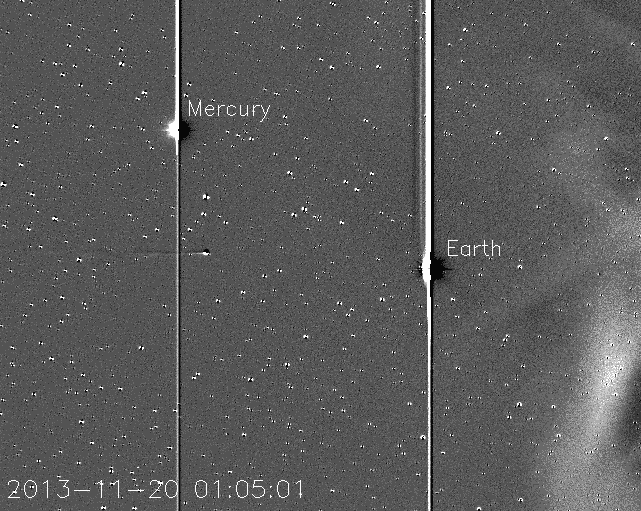 Astro Picture of the Day: November 24, 2013  Comet Hale-Bopp, the Great Comet of 1997, was quite a sight. In the above photograph taken on 1997 April 6, Comet Hale-Bopp was imaged from the Indian Cove Campground in the Joshua Tree National Park in California, USA. A flashlight was used to momentarily illuminate foreground rocks in this six minute exposure. An impressive blue ion tail was visible above a sunlight-reflecting white dust tail. Comet Hale-Bopp remained visible to the unaided eye for over a year before returning to the outer Solar System and fading. As Comet ISON approaches the Sun this week, sky enthusiasts around the Earth are waiting to see if its tails will become even more spectacular than those displayed by Comet Hale-Bopp.
__________________
1st in Kommisar's 2009 SM Tournament 1st in I Love You`s 2009 New Year`s Tournament 3rd in EnR's Mashfest '08 tournament 5th in Phynx's Unofficial FFR Tournament 9th in D3 of the 2008-2009 4th Official FFR Tournament 10th in D5 of the 2010 5th Official FFR Tournament 10th in D6 of the 2011-2012 6th Official FFR Tournament FMO AAA Count: 71 FGO AAA Count: 10 Bluearrowll = The Canadian player who can not detect awkward patterns. If it's awkward for most people, it's normal for Terry. If the file is difficult but super straight forward, he has issues. If he's AAAing a FGO but then heard that his favorite Hockey team was losing by a point, Hockey > FFR PS: Cool AAA's Terry - I Love You An Alarm Clock's Haiku beep beep beep beep beep beep beep beep beep beep beep beep beep beep beep beep beep - ieatyourlvllol |
|
|

|
|
|
#752 |
|
⊙▃⊙
|
What's in the sky tonight?
November 25, 2013 -Last-quarter Moon (exact at 2:28 p.m. EST). The Moon rises around 1 a.m. tonight. By dawn Tuesday morning it's high in the south, with Regulus to its right and Mars to its lower left. -As Comet ISON approaches the sun, it is becoming increasingly difficult for observers on Earth to photograph the comet. Indeed, by Nov. 24th it seemed impossible. But it only seemed that way. Working from a high-altitude site in the Canary islands, Juan Carlos Casado successfully imaged Comet ISON on Sunday morning deep inside the rosy glow of dawn. "I took this picture of Comet ISON on Nov. 24th at 6: 25 UT from the Teide Observatory," says Casado. "The comet was over the distant island of Gran Canaria above a sea of clouds about 1 hour before sunrise and only 16° from the sun. The exceptional atmospheric conditions of Teide Observatory allowed me to capture the image." 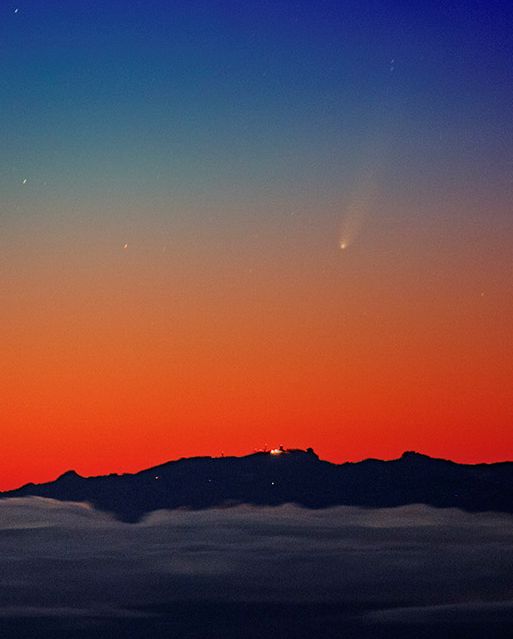 Astro Picture of the Day: November 25, 2013 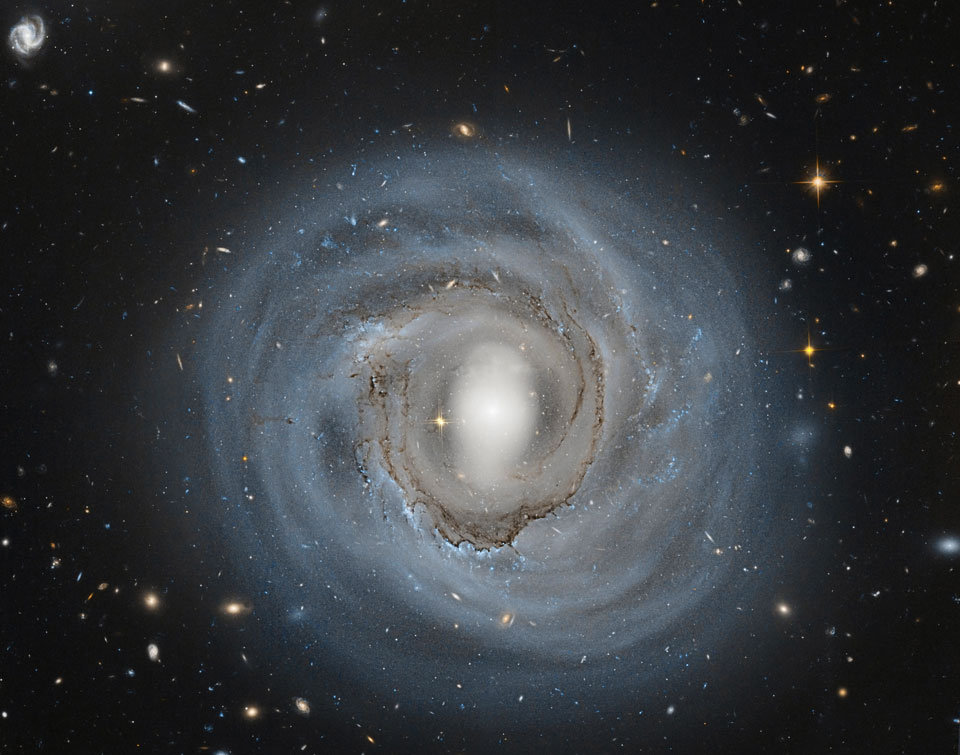 How far away is spiral galaxy NGC 4921? Although presently estimated to be about 310 million light years distant, a more precise determination could be coupled with its known recession speed to help humanity better calibrate the expansion rate of the entire visible universe. Toward this goal, several images were taken by the Hubble Space Telescope in order to help identify key stellar distance markers known as Cepheid variable stars. Since NGC 4921 is a member of the Coma Cluster of Galaxies, refining its distance would also allow a better distance determination to one of the largest nearby clusters in the local universe. The magnificent spiral NGC 4921 has been informally dubbed anemic because of its low rate of star formation and low surface brightness. Visible in the above image are, from the center, a bright nucleus, a bright central bar, a prominent ring of dark dust, blue clusters of recently formed stars, several smaller companion galaxies, unrelated galaxies in the far distant universe, and unrelated stars in our Milky Way Galaxy.
__________________
1st in Kommisar's 2009 SM Tournament 1st in I Love You`s 2009 New Year`s Tournament 3rd in EnR's Mashfest '08 tournament 5th in Phynx's Unofficial FFR Tournament 9th in D3 of the 2008-2009 4th Official FFR Tournament 10th in D5 of the 2010 5th Official FFR Tournament 10th in D6 of the 2011-2012 6th Official FFR Tournament FMO AAA Count: 71 FGO AAA Count: 10 Bluearrowll = The Canadian player who can not detect awkward patterns. If it's awkward for most people, it's normal for Terry. If the file is difficult but super straight forward, he has issues. If he's AAAing a FGO but then heard that his favorite Hockey team was losing by a point, Hockey > FFR PS: Cool AAA's Terry - I Love You An Alarm Clock's Haiku beep beep beep beep beep beep beep beep beep beep beep beep beep beep beep beep beep - ieatyourlvllol |
|
|

|
|
|
#753 |
|
⊙▃⊙
|
What's in the sky tonight?
November 26, 2013 -Jupiter's Great Red Spot should cross the planet's central meridian around 11:36 p.m. Eastern Standard Time tonight. The tiny black shadow of Jupiter's moon Io crosses the planet's face from 11:47 p.m. EST to 2:01 a.m. EST. -By about 2 a.m. Wednesday morning the waning Moon is up in the east with Mars shining to its left. By dawn Wednesday morning, they're high in the southeast. -Comet ISON is getting all the press, but there is a second comet near the sun as well: Comet Encke. NASA's STEREO-A spacecraft is monitoring both. Click to view an updated movie of the solar wind buffeting two comets. In the movie, which spans a three+ day period from Nov. 20 to Nov. 23, the sun is to the right, off-screen. At first glance, Earth and Mercury appear to be labeled backwards. The strange arrangement is actually correct. This is how the two planets appear from STEREO-A's vantage point over the farside of the sun. "The dark 'clouds' moving from left to right are density enhancements in the solar wind, and these are what are causing the ripples you see in the comet tails," explains Karl Battams of NASA's Comet ISON Observing Campaign. The ripples could become even more dramatic if a CME hits the comets. This is Comet ISON's first visit to the sun, but Comet Encke has been here before. In 2007 a CME hit Encke and ripped off its tail. Battams and other researchers hope something similar is about to happen now. "I'd love to see a big CME hit Comet ISON," he says in a story from Science@NASA. Watching the impact could teach researchers new things about CMEs and comets. 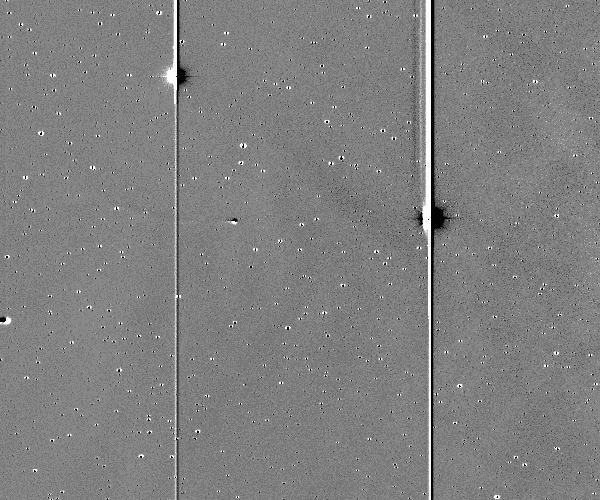 Astro Picture of the Day: November 26, 2013  One might say this was a bell weather day for the Sierra Nevada mountains. In January, just as the Sun was setting above the district of Albayzín in Grenada, Spain, a huge cloud appeared as a bell capping the Veleta peak. Such a Cap cloud is formed by air forced upwards by a mountain peak, with the air then cooling, saturating with moisture, and finally having its molecular water condense into cloud droplets. Such a bell-shaped cloud structure is unusual as air typically moves horizontally, making most clouds nearly flat across at the bottom. Vertical waves can also give additional lenticular cloud layers, as also seen above. Given the fleeting extent of the great cloud coupled with momentarily excellent sunset coloring, one might considered this also a bellwether day for an accomplished photographer.
__________________
1st in Kommisar's 2009 SM Tournament 1st in I Love You`s 2009 New Year`s Tournament 3rd in EnR's Mashfest '08 tournament 5th in Phynx's Unofficial FFR Tournament 9th in D3 of the 2008-2009 4th Official FFR Tournament 10th in D5 of the 2010 5th Official FFR Tournament 10th in D6 of the 2011-2012 6th Official FFR Tournament FMO AAA Count: 71 FGO AAA Count: 10 Bluearrowll = The Canadian player who can not detect awkward patterns. If it's awkward for most people, it's normal for Terry. If the file is difficult but super straight forward, he has issues. If he's AAAing a FGO but then heard that his favorite Hockey team was losing by a point, Hockey > FFR PS: Cool AAA's Terry - I Love You An Alarm Clock's Haiku beep beep beep beep beep beep beep beep beep beep beep beep beep beep beep beep beep - ieatyourlvllol |
|
|

|
|
|
#754 |
|
⊙▃⊙
|
What's in the sky tonight?
November 27, 2013 -The Earthside of the sun is quiet. NOAA forecasters estimate a slim 1% chance of either M- or X-class solar flares on Nov. 27th. However, there is at least one active region on the farside of the sun which could target Comet ISON when it swings around the farside after Nov. 28th. -Comet ISON is hurtling toward the sun today at 240,000 mph and, despite the rising heat, the comet appears to be intact. Yesterday, reports of fading spectral lines from the comet's core raised concerns that the icy nucleus might be disintegrating. Current images from NASA and ESA spacecraft, however, show the comet still going strong. Comet ISON has just entered the field of view of the Solar and Heliospheric Observatory (SOHO). -The comet's entrance coincides with a bright CME racing away from the sun's southwestern limb. Astronomers have been wondering what might happen if a CME strikes Comet ISON. This CME, however, will probably miss. The source of the cloud is a farside active region, which is not directly facing the comet. -Astronomer Karl Battams of NASA's Comet ISON Observing Campaign urges readers to remember the following: "Comet ISON is a dynamically new sungrazing comet, fresh in from the Oort Cloud, and the last time we saw an object like this was never! Furthermore, a sungrazing comet just days from perihelion has never been studied in this kind of detail - we're breaking new ground! When we factor in your standard 'comets are unpredictable' disclaimer, what we have is a huge recipe for the unknown." 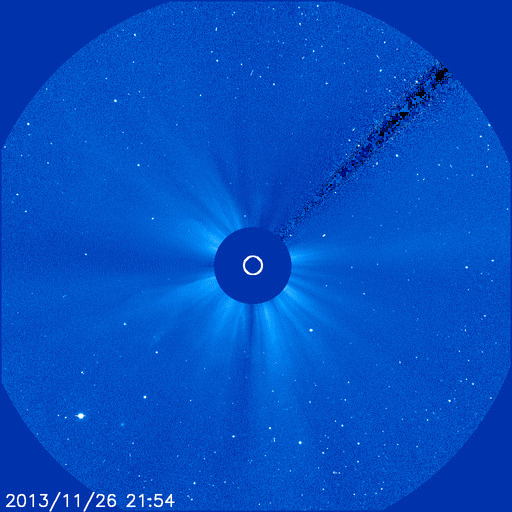 Significant ISON Satellite Dates: • Nov. 21–28: STEREO-A, Heliospheric Imager. • Nov. 26–29: STEREO-B, coronagraphs. Stereo-B will be the only craft to watch ISON transit the face of the Sun. • Nov. 27–30: SOHO, coronagraphs. • Nov. 28–29: STEREO-A, coronagraphs. • Nov. 28: Solar Dynamics Observatory (SDO); for about 3 hours around perihelion. • Nov. 28: Japan's Hinode, X-Ray Telescope; for about 55 minutes around perihelion. Astro Picture of the Day: November 27, 2013 Will Comet ISON survive tomorrow's close encounter with the Sun? Approaching to within a solar diameter of the Sun's surface, the fate of one of the most unusual comets of modern times will finally be determined. The comet could shed a great amount of ice and dust into a developing tail - or break apart completely. Unfortunately, the closer Comet ISON gets to the Sun, the harder it has been for conventional telescopes to see the brightening comet in the glare of the morning Sun. Pictured in the above short time lapse video, Comet ISON was captured rising over the Canary Islands just above the morning Sun a few days ago. If the comet's nucleus survives, the coma and the tails it sheds might well be visible rising ahead of the Sun in the next few days or weeks. Alternatively, satellites watching the Sun might document one of the larger comet disintegrations yet recorded. Stay tuned!
__________________
1st in Kommisar's 2009 SM Tournament 1st in I Love You`s 2009 New Year`s Tournament 3rd in EnR's Mashfest '08 tournament 5th in Phynx's Unofficial FFR Tournament 9th in D3 of the 2008-2009 4th Official FFR Tournament 10th in D5 of the 2010 5th Official FFR Tournament 10th in D6 of the 2011-2012 6th Official FFR Tournament FMO AAA Count: 71 FGO AAA Count: 10 Bluearrowll = The Canadian player who can not detect awkward patterns. If it's awkward for most people, it's normal for Terry. If the file is difficult but super straight forward, he has issues. If he's AAAing a FGO but then heard that his favorite Hockey team was losing by a point, Hockey > FFR PS: Cool AAA's Terry - I Love You An Alarm Clock's Haiku beep beep beep beep beep beep beep beep beep beep beep beep beep beep beep beep beep - ieatyourlvllol Last edited by Bluearrowll; 11-27-2013 at 09:32 AM.. |
|
|

|
|
|
#755 |
|
⊙▃⊙
|
What's in the sky tonight?
November 28, 2013 -Comet ISON is brightening rapidly as it plunges into the sun's atmosphere. At closest approach around 1:45 p.m. EST on Nov. 28th (Thanksgiving Day in the USA), the comet will be little more than a million kilometers above the sun's fiery surface. Temperatures around ISON's icy nucleus could rise as high as 5000o F. No one knows if it can survive that kind of baking--but if it does, it could emerge as a splendid naked-eye comet in early December. Right now, the best views of the comet are coming from the Solar and Heliospheric Observatory (SOHO). Over the course of the animation, Comet ISON brightens by a factor of at least four, and possibly as much as a factor of 10. It easily outshines the 1st-magnitude red giant star Antares to the lower left of the sun. Researchers have been wondering what might happen if a CME strikes Comet ISON. They might find out before the day is over. As the movie shows, CMEs are billowing away from the sun in all directions. Avoiding a collision will become increasingly difficult as the comet moves closer to active regions on the sun's surface. During the hours around closest approach, NASA's Solar Dynamics Observatory (SDO) will take high-resolution pictures of the comet flying through the sun's atmosphere. This diagram below illustrates the sequence of events. Usually, SDO points straight at the sun. In this case, however, the observatory is being offset and moved three times to track the speeding comet. SDO images of sungrazing Comet Lovejoy in Dec. 2011 were dramatic. Comet ISON could be even better. 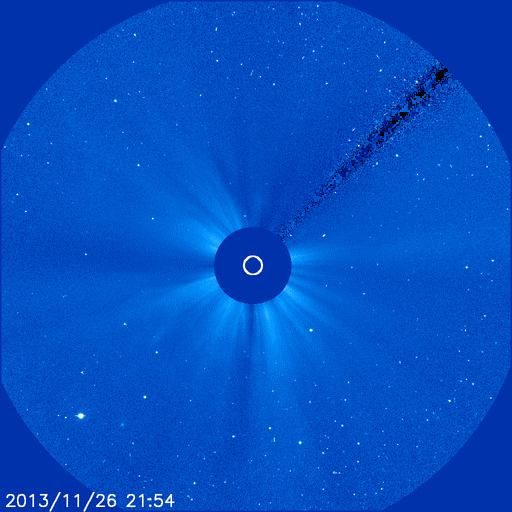 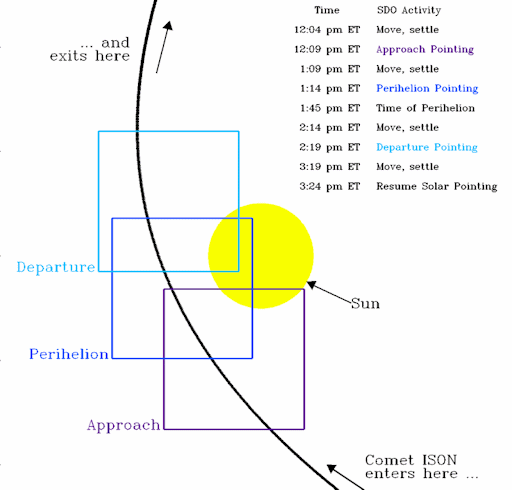  Astro Picture of the Day: November 28, 2013  South of the large star-forming region known as the Orion Nebula, lies bright blue reflection nebula NGC 1999. At the edge of the Orion molecular cloud complex some 1,500 light-years distant, NGC 1999's illumination is provided by the embedded variable star V380 Orionis. That nebula is marked with a dark sideways T-shape near center in this cosmic vista that spans about 10 light-years. The dark shape was once assumed to be an obscuring dust cloud seen in silhouette against the bright reflection nebula. But recent infrared images indicate the shape is likely a hole blown through the nebula itself by energetic young stars. In fact, this region abounds with energetic young stars producing jets and outflows with luminous shock waves. Cataloged as Herbig-Haro (HH) objects, named for astronomers George Herbig and Guillermo Haro, the shocks look like red gashes in this scene that includes HH1 and HH2 just below NGC 1999. The stellar jets push through the surrounding material at speeds of hundreds of kilometers per second.
__________________
1st in Kommisar's 2009 SM Tournament 1st in I Love You`s 2009 New Year`s Tournament 3rd in EnR's Mashfest '08 tournament 5th in Phynx's Unofficial FFR Tournament 9th in D3 of the 2008-2009 4th Official FFR Tournament 10th in D5 of the 2010 5th Official FFR Tournament 10th in D6 of the 2011-2012 6th Official FFR Tournament FMO AAA Count: 71 FGO AAA Count: 10 Bluearrowll = The Canadian player who can not detect awkward patterns. If it's awkward for most people, it's normal for Terry. If the file is difficult but super straight forward, he has issues. If he's AAAing a FGO but then heard that his favorite Hockey team was losing by a point, Hockey > FFR PS: Cool AAA's Terry - I Love You An Alarm Clock's Haiku beep beep beep beep beep beep beep beep beep beep beep beep beep beep beep beep beep - ieatyourlvllol |
|
|

|
|
|
#756 |
|
⊙▃⊙
|
For a brief couple hours, live NASA coverage of Comet ISON.
__________________
1st in Kommisar's 2009 SM Tournament 1st in I Love You`s 2009 New Year`s Tournament 3rd in EnR's Mashfest '08 tournament 5th in Phynx's Unofficial FFR Tournament 9th in D3 of the 2008-2009 4th Official FFR Tournament 10th in D5 of the 2010 5th Official FFR Tournament 10th in D6 of the 2011-2012 6th Official FFR Tournament FMO AAA Count: 71 FGO AAA Count: 10 Bluearrowll = The Canadian player who can not detect awkward patterns. If it's awkward for most people, it's normal for Terry. If the file is difficult but super straight forward, he has issues. If he's AAAing a FGO but then heard that his favorite Hockey team was losing by a point, Hockey > FFR PS: Cool AAA's Terry - I Love You An Alarm Clock's Haiku beep beep beep beep beep beep beep beep beep beep beep beep beep beep beep beep beep - ieatyourlvllol |
|
|

|
|
|
#757 |
|
⊙▃⊙
|
What's in the sky tonight?
November 29, 2013 -Cancel the funeral. Comet ISON is back from the dead. Yesterday, Nov. 28th, Comet ISON flew through the sun's atmosphere and appeared to disintegrate before the cameras of several NASA and ESA spacecraft. This prompted reports of the comet's demise. Today, the comet has revived and is rapidly brightening. -Before the flyby, experts had made many predictions about what might happen to the comet, ranging from utter disintegration to glorious survival. No one predicted both. Karl Battams of NASA's Comet ISON Observing Campaign says, "[colleague] Matthew Knight and I are ripping our hair out right now as we know that so many people in the public, the media and in science teams want to know what's happened. We'd love to know that too! Right now, here's our working hypothesis: "As comet ISON plunged towards to the Sun, it began to fall apart, losing not giant fragments but at least a lot of reasonably sized chunks. There's evidence of very large dust in the long thin tail we saw in the [SOHO coronagraph] images. Then, as ISON plunged through the corona, it continued to fall apart and vaporize, losing its coma and tail completely just like sungrazing Comet Lovejoy did in 2011. What emerged from the Sun was a small but perhaps somewhat coherent nucleus that has resumed emitting dust and gas for at least the time being." Battams emphasizes that it is too soon to tell how big the remnant nucleus is or how bright the resurgent comet will ultimately become. "We have a whole new set of unknowns, and this ridiculous, crazy, dynamic and unpredictable object continues to amaze, astound and confuse us to no end. We ask that you please be patient with us for a couple of days as we analyze the data and try to work out what is happening." Astrophotographer Babak Tafreshi has edited an HD video that compares views of ISON from both of SOHO's coronagraphs. "It seems the comet could become a naked eye object with several degrees of scattered tail by Dec 2nd or 3rd," he predicts. "It's not the comet of the century for sure, and fainter than the Lovejoy sungrazer in Dec. 2011, but an interesting imaging target is just a few nights away!" His video can be found here; http://vimeo.com/80568171  Astro Picture of the Day: November 29, 2013 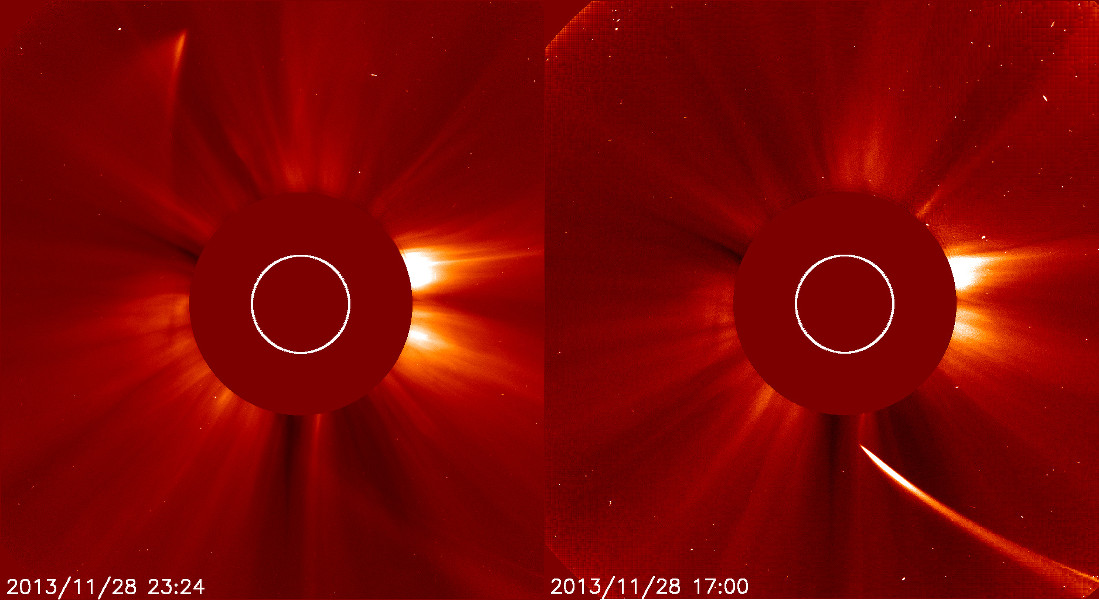 Sungrazing Comet ISON reached perihelion, its closest approach to the Sun, yesterday, November 28, at 18:45 UT. The comet passed just over 1 million kilometers above the solar surface, a distance less than the diameter of the Sun. These two panels follow ISON before (right) and after its close approach, imaged by the LASCO instrument onboard the Sun staring SOHO spacecraft. Overwhelming sunlight is blocked by LASCO's central occulting disk with a white circle indicating the Sun's positon and scale. The bright comet is seen along its path at the bottom of the before panel, but something much fainter exits near the top of the after panel, potentially a dust tail reforming from the debris left from ISON's perihelion passage. Latest ISON Image 
__________________
1st in Kommisar's 2009 SM Tournament 1st in I Love You`s 2009 New Year`s Tournament 3rd in EnR's Mashfest '08 tournament 5th in Phynx's Unofficial FFR Tournament 9th in D3 of the 2008-2009 4th Official FFR Tournament 10th in D5 of the 2010 5th Official FFR Tournament 10th in D6 of the 2011-2012 6th Official FFR Tournament FMO AAA Count: 71 FGO AAA Count: 10 Bluearrowll = The Canadian player who can not detect awkward patterns. If it's awkward for most people, it's normal for Terry. If the file is difficult but super straight forward, he has issues. If he's AAAing a FGO but then heard that his favorite Hockey team was losing by a point, Hockey > FFR PS: Cool AAA's Terry - I Love You An Alarm Clock's Haiku beep beep beep beep beep beep beep beep beep beep beep beep beep beep beep beep beep - ieatyourlvllol Last edited by Bluearrowll; 11-29-2013 at 03:06 PM.. |
|
|

|
|
|
#758 |
|
⊙▃⊙
|
What's in the sky tonight?
November 30, 2013 -A bright CME (coronal mass ejection) blasted away from the farside of the sun during the early hours of Nov. 30th. Although the cloud appears to overrun the comet in movies from SOHO (watch), in fact it probably missed or delivered no more than a glancing blow. That's too bad, because a CME impact could reveal the true nature of Comet ISON's mysterious undead core. -Comet ISON continues to do the exact opposite of what scientists have forecasted it to do. At 19:54 UT Filip Fratev (Bulgarian Acadamy of Sciences) wrote, "ISON [has] started to fade.... [In] the last four hours it faded by more than 2 magnitudes and obviously is less bright... I estimated the comet to be between 2.6 and 3.1 magnitude now." Four hours later Karl Battams of the Comet ISON Observing Campaign tweeted, "We can't tell if #ISON is in one piece or many. It's about mag 5 now and fading." -Which rises first: bright Jupiter in the east-northeast, or bright Rigel in Orion's foot in the east-southeast? Both are up by about 8 p.m. depending on where you live. At the latitudes of the U.S. and southern Canada, Rigel comes first tonight. As far north as Paris (latitude 49°) and points farther north, Jupiter is first.  Astro Picture of the Day: November 30, 2013 After failing to appear for Sun staring spacecraft at perihelion, its harrowing closest approach to the Sun, sungrazing Comet ISON was presumed lost. But ISON surprised observers yesterday as material still traveling along the comet's trajectory became visible and even developed an extensive fan-shaped dust tail. Edited and processed to HD format, this video (vimeo, youtube) is composed of frames from the SOHO spacecraft's coronographs. It follows the comet in view of the wide (blue tint) and narrow (red tint) field cameras in the hours both before and after perihelion passage. In both fields, overwhelming sunlight is blocked by a central occulting disk. A white circle indicates the Sun's positon and scale. With questions to be answered and the tantalizing possibility that a small cometary nucleus has survived in whole or part, surprising comet ISON will be rising before dawn in planet Earth's skies in the coming days.
__________________
1st in Kommisar's 2009 SM Tournament 1st in I Love You`s 2009 New Year`s Tournament 3rd in EnR's Mashfest '08 tournament 5th in Phynx's Unofficial FFR Tournament 9th in D3 of the 2008-2009 4th Official FFR Tournament 10th in D5 of the 2010 5th Official FFR Tournament 10th in D6 of the 2011-2012 6th Official FFR Tournament FMO AAA Count: 71 FGO AAA Count: 10 Bluearrowll = The Canadian player who can not detect awkward patterns. If it's awkward for most people, it's normal for Terry. If the file is difficult but super straight forward, he has issues. If he's AAAing a FGO but then heard that his favorite Hockey team was losing by a point, Hockey > FFR PS: Cool AAA's Terry - I Love You An Alarm Clock's Haiku beep beep beep beep beep beep beep beep beep beep beep beep beep beep beep beep beep - ieatyourlvllol |
|
|

|
|
|
#759 |
|
⊙▃⊙
|
What's in the sky tonight?
December 1, 2013 -NOAA forecasters estimate a 25% chance of polar geomagnetic storms on Dec. 2nd when a CME might deliver a glancing blow to Earth's magnetic field. High-latitude sky watchers should be alert for auroras. -John Bortle withdraws his relatively optimistic forecast posted yesterday. He writes, The comet's appearance only suggests a progressive decline now. While ISON's photometric behavior up to and around perihelion did seem to mimic that of 1962's impressive Comet Seki-Lines, the failure of ISON's current cloud-like coma to exhibit any area of condensation as the cloud thins, and its fading and growing diffuseness, do not correspond to Seki-Lines' post-perihelion regeneration.... To be similar in behavior with C/Seki-Lines, ISON would be developing an increasingly small, dense, very bright condensation within the coma. Likewise, the intensity and length of the tail(s) would be rapidly growing, just as we saw in the case of 2011 W3 Lovejoy following its perihelion.... Following a 2- to 4-day blind period after the comet leaves spacecraft view, Bortle expects only a "large, low-surface-brightness, diffuse cloud showing just a trace of tail" — in other words a challenge object for skilled astrophotographers and image processers, not visual observers — if anything at all. -Comet ISON is fading fast as it recedes from the sun. Whatever piece of the comet briefly survived its Thanksgiving Day brush with solar fire is now dissipating in a cloud of dust. This development makes it unlikely that Comet ISON will put on a good show after it exits the glare of the sun in early December. Experienced astrophotographers might be able to capture the comet's fading "ghost" in the pre-dawn sky, but a naked-eye spectacle is out of the question. On Nov. 29th, pilot Brian Whittaker tried to catch a first glimpse of Comet ISON from Earth, post-perihelion, from a plane flying 36,000 feet over the Arctic Circle in northern Canada. No luck. "Ideal viewing conditions from the Arctic revealed no Comet ISON," reports Whittaker. "This negative report is to quench the thirst of other fellow dreamers under cloudy skies or further south. Later I could see that SOHO showed the comet dimming further." Despite Whittaker's negative result, it is too soon to rule out observations from Earth as the twice-dead comet moves away from the glare of the sun. Meanwhile, NASA's fleet of solar observatory will be tracking the remains. Stay tuned for more images.  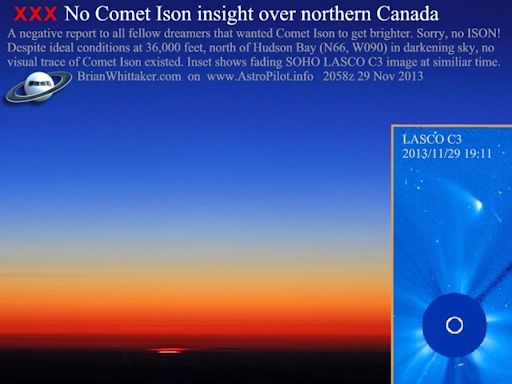 Astro Picture of the Day: December 1, 2013 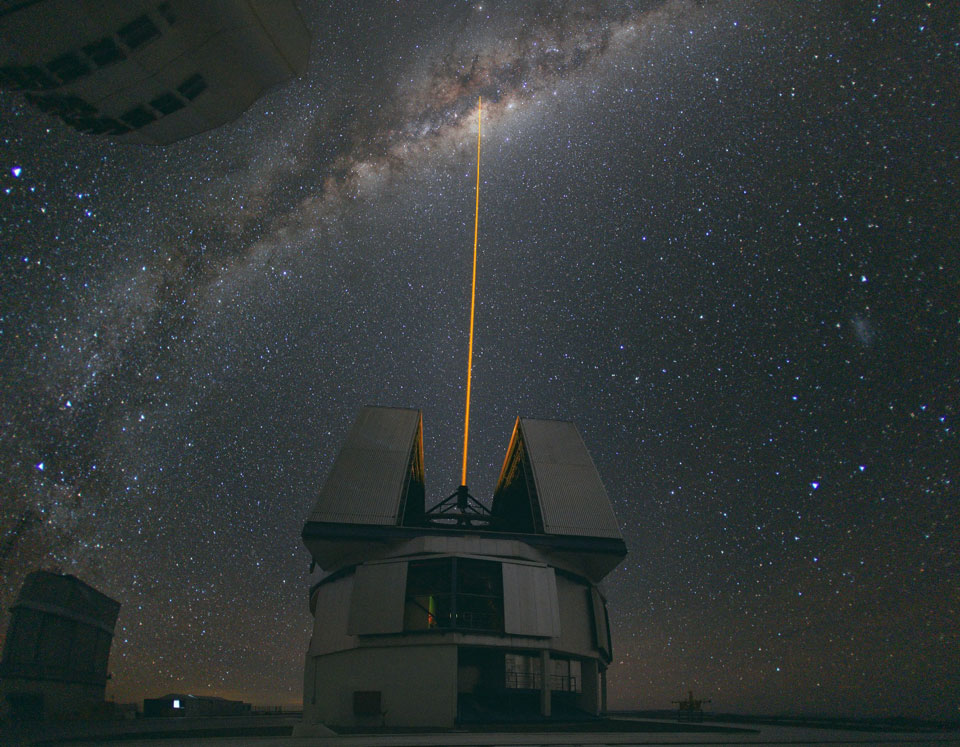 Why are these people shooting a powerful laser into the center of our Galaxy? Fortunately, this is not meant to be the first step in a Galactic war. Rather, astronomers at the Very Large Telescope (VLT) site in Chile are trying to measure the distortions of Earth's ever changing atmosphere. Constant imaging of high-altitude atoms excited by the laser -- which appear like an artificial star -- allow astronomers to instantly measure atmospheric blurring. This information is fed back to a VLT telescope mirror which is then slightly deformed to minimize this blurring. In this case, a VLT was observing our Galaxy's center, and so Earth's atmospheric blurring in that direction was needed. As for inter-galaxy warfare, when viewed from our Galaxy's center, no casualties are expected. In fact, the light from this powerful laser would combine with light from our Sun to together appear only as bright as a faint and distant star.
__________________
1st in Kommisar's 2009 SM Tournament 1st in I Love You`s 2009 New Year`s Tournament 3rd in EnR's Mashfest '08 tournament 5th in Phynx's Unofficial FFR Tournament 9th in D3 of the 2008-2009 4th Official FFR Tournament 10th in D5 of the 2010 5th Official FFR Tournament 10th in D6 of the 2011-2012 6th Official FFR Tournament FMO AAA Count: 71 FGO AAA Count: 10 Bluearrowll = The Canadian player who can not detect awkward patterns. If it's awkward for most people, it's normal for Terry. If the file is difficult but super straight forward, he has issues. If he's AAAing a FGO but then heard that his favorite Hockey team was losing by a point, Hockey > FFR PS: Cool AAA's Terry - I Love You An Alarm Clock's Haiku beep beep beep beep beep beep beep beep beep beep beep beep beep beep beep beep beep - ieatyourlvllol |
|
|

|
|
|
#760 |
|
⊙▃⊙
|
What's in the sky tonight?
December 2, 2013 -Mars is passing 1.2° upper left of the 3.6-magnitude star Beta Virginis before dawn this morning and tomorrow morning — a sidelight from the Comet ISON hunt. Look for Mars shining very high in the southeast before dawn gets too bright. -Following its Thanksgiving Day brush with solar fire, sundiving Comet ISON is now just a cloud of dust. Among experts, a consensus is building that the comet broke apart shortly before perihelion (closest approach to the sun). In the movie, note how rapidly the comet fades just before it vanishes behind the occulting disk of the SOHO coronagraph. -After perihelion, the comet emerges as a diffuse remnant of its former self. No one knows for sure what is inside that fan-shaped cloud. Possibilities include a small remnant nucleus or a "rubble pile" of furiously vaporizing fragments. By the end of the day on Nov. 28th, Comet ISON was spent. As of Dec. 2nd, the cloud of debris is no brighter than a star of approximately 8th magnitude. Experienced astrophotographers might be able to capture the comet's fading "ghost" in the pre-dawn sky of early December, but a naked-eye spectacle is out of the question. -China is about to join the club of nations that have landed on the Moon. On Dec. 1st, China's Chang'e-3 spacecraft blasted off from the Sichuan province in southwest China. It's payload: a six-wheeled, 260-lb rover named the "Jade Rabbit" ("Yutu" in Chinese), which could touch down on the lunar surface as early as Dec. 14th. -Unlike the soft landings of unmanned spacecraft from the USA and the Soviet Union, Chang'e-3 will be able to survey the landscape first and determine the safest spot. The most likely destination is Sinus Iridum, the Bay of Rainbows. A Chinese-made nuclear battery will power the rover after it lands on the lunar surface. Using plutonium-238, the battery will last for more than 30 years. The rover also has expandable solar arrays to absorb the sun’s energy during the day and retract at night to cover and protect equipment from temperatures of minus 170 degrees Celsius. Onboard sensors include a ground-probing radar, cameras, and a soil sampler. Jade Rabbit's name comes a Chinese myth: According to the ancient story, a lady called Chang'e swallowed magic pills, which allowed her to fly to the Moon along with her pet rabbit "Yutu". There she became a goddess, and has been living on the Moon with the white rabbit ever since.  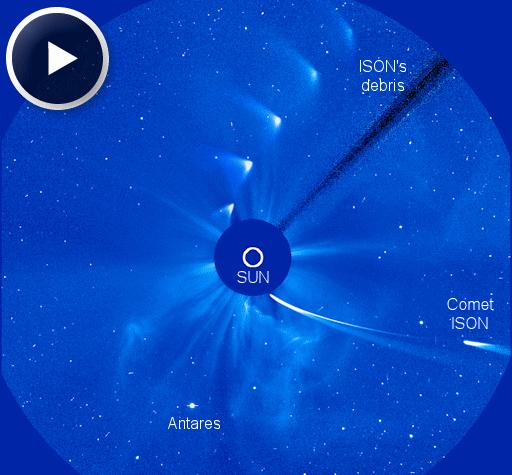 [img] Astro Picture of the Day: December 2, 2013 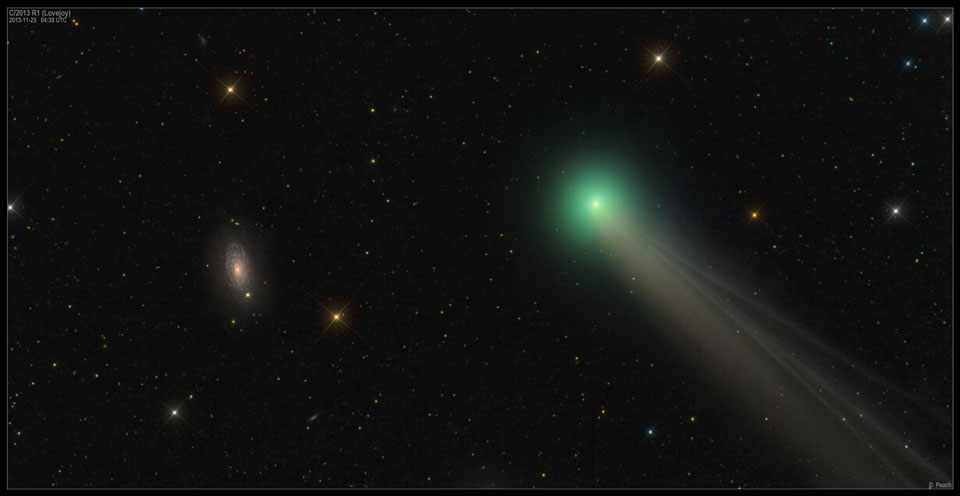 Comet Lovejoy was captured last week passing well in front of spiral galaxy M63. Discovered only three months ago and currently near its maximum brightness, Comet Lovejoy can be seen near the Big Dipper from dark northerly locations before dawn with the unaided eye. An unexpected rival to Comet ISON, C/2013 R1 (Lovejoy), pictured above, is currently sporting a large green coma and a beautifully textured ion tail. Comet Lovejoy is now headed back to the outer Solar System but should remain a good sight in binoculars for another few weeks. Conversely, spiral galaxy M63, lies far in the distance and is expected to remain stationary on the sky and hold its relative brightness for at least the next few million years.
__________________
1st in Kommisar's 2009 SM Tournament 1st in I Love You`s 2009 New Year`s Tournament 3rd in EnR's Mashfest '08 tournament 5th in Phynx's Unofficial FFR Tournament 9th in D3 of the 2008-2009 4th Official FFR Tournament 10th in D5 of the 2010 5th Official FFR Tournament 10th in D6 of the 2011-2012 6th Official FFR Tournament FMO AAA Count: 71 FGO AAA Count: 10 Bluearrowll = The Canadian player who can not detect awkward patterns. If it's awkward for most people, it's normal for Terry. If the file is difficult but super straight forward, he has issues. If he's AAAing a FGO but then heard that his favorite Hockey team was losing by a point, Hockey > FFR PS: Cool AAA's Terry - I Love You An Alarm Clock's Haiku beep beep beep beep beep beep beep beep beep beep beep beep beep beep beep beep beep - ieatyourlvllol |
|
|

|
 |
| Currently Active Users Viewing This Thread: 1 (0 members and 1 guests) | |
|
|